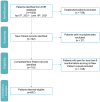The burden of Chronic Pelvic Pain (CPP): Costs and quality of life of women and men with CPP treated in outpatient referral centers
- PMID: 36757947
- PMCID: PMC9910684
- DOI: 10.1371/journal.pone.0269828
The burden of Chronic Pelvic Pain (CPP): Costs and quality of life of women and men with CPP treated in outpatient referral centers
Abstract
Introduction: Chronic Pelvic Pain (CPP) is a complex, multifaceted condition that affects both women and men. There is limited literature on the cost utilization the healthcare system and CPP patients incur. The purpose of this analysis is to characterize the overall healthcare utilization, cost burden, and quality-of-life restrictions experienced by CPP patients using data from an outpatient pelvic rehabilitation practice.
Methods: Healthcare utilization data was gathered by systematically reviewing and analyzing data from new patient visit progress notes stored in the clinic's electronic health records (EHR). We obtained in-network costs by using the FAIR Health Consumer online database. Overall costs were then calculated as the utilization times the per-unit costs from the FAIR database. Additionally, data on patients' visual analogue scale (VAS), absenteeism, presenteeism emergency room visits, usage of common pain medications, use of diagnostics, and participation in common treatment modalities was gathered.
Results: Data from 607 patients was used. The overall cost burden per patient for all surgeries combined was $15,750 for in-network services. The cost burden for diagnostics was $5,264.22 and treatments was $8,937 per patient for in-network treatments.
Conclusion: Chronic Pelvic Pain was found to have a large cost burden of $29,951 for in-network services which includes treatments, diagnostics, and surgeries. This analysis sets the stage for future investigations involving data on costs of medications that patients have tried prior to presenting to us and costs associated with work hours lost.
Copyright: © 2023 Hutton et al. This is an open access article distributed under the terms of the Creative Commons Attribution License, which permits unrestricted use, distribution, and reproduction in any medium, provided the original author and source are credited.
Conflict of interest statement
The authors have declared that no competing interests exist.
Figures
References
-
- Allaire C, Williams C, Bodmer-Roy S, Zhu S, Arion K, Ambacher K, et al.. Chronic pelvic pain in an interdisciplinary setting: 1-year prospective cohort: 1-Year prospective cohort. Obstet Gynecol Surv. 2018;73(5):276–7. - PubMed
-
- Collins MM, Stafford RS, O’Leary MP, Barry MJ. How common is prostatitis? A national survey of physician visits. J Urol. 1998;159(4):1224–8. - PubMed
MeSH terms
LinkOut - more resources
Full Text Sources
Medical





